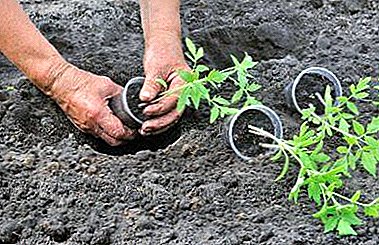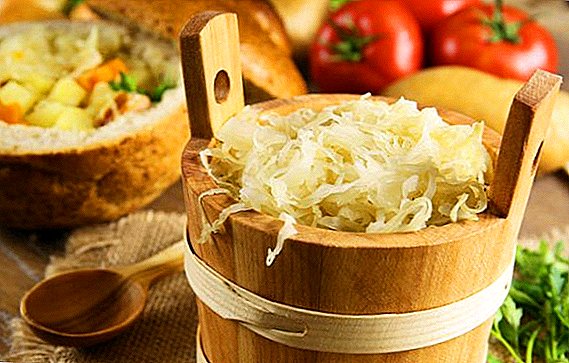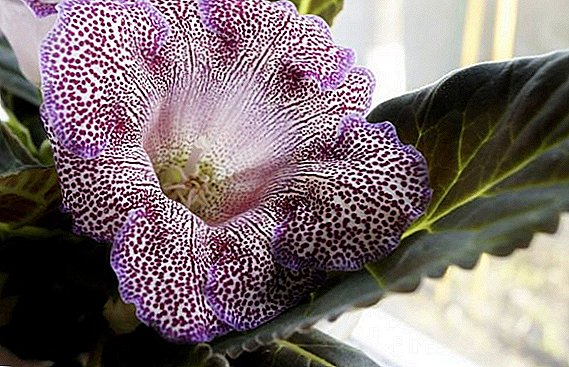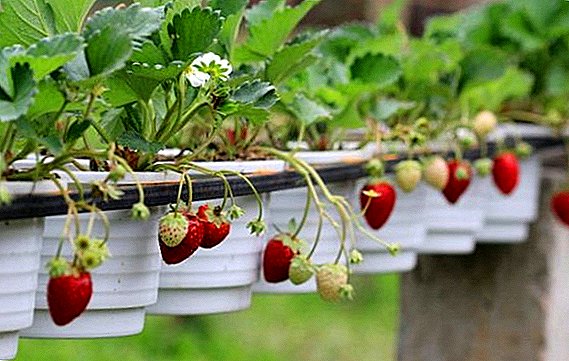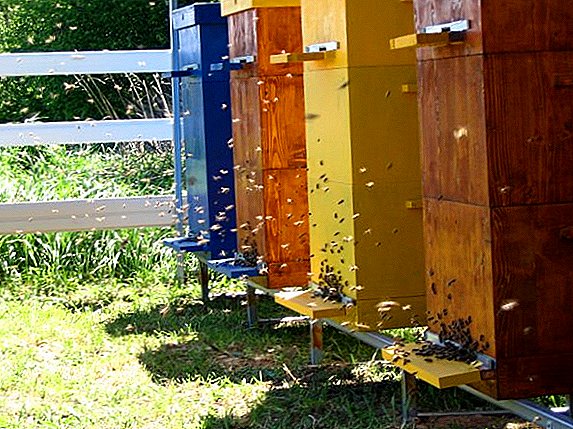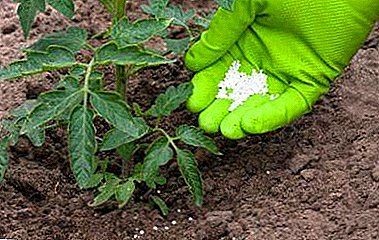
Before gardeners, who chose to grow tomatoes in greenhouses, there is always an acute question about how to feed a plant so that it does not hurt and gives a good harvest. The fact is that greenhouse top dressing has its own characteristics, and besides, tomato is a rather capricious crop that constantly requires care and needs to create suitable conditions.
In the article you can read about the correctness of the dressing of tomatoes during germination and planting in a greenhouse, for example, from polycarbonate, as well as about caring for tomatoes.
Features and differences in the growth of tomatoes
- Growing tomatoes in a greenhouse depends on the right variety. For greenhouses choose varieties characterized by resistance to diseases, easy tolerance of temperature changes and some lack of lighting. Low-growing plants are suitable for small seasonal greenhouses, and tall varieties for spacious rooms.
- Soil preparation is carried out in advance. It needs to be heated, in the absence of heating, the doors and windows are tightly closed, and the ground is well loosened. Soil temperature for planting is +10 degrees.
- Planting seedlings perform 50 days after germination. In the pre-watered soil, pits are made, a tablespoon of mineral fertilizer is thrown there, poured with potassium permanganate, and tomatoes are planted. Before planting, lower leaves are removed from seedlings.
- The appropriate temperature - 23-26 degrees, timely food and regular watering - the basic care for this culture. For irrigation it is convenient to use automated systems: rain, drip, subsurface.
The need for special substances
Fertilizers for tomatoes are mineral and organic, they are used in a dry, liquid or semi-liquid state. The treatment itself is carried out repeatedly and in different ways.
Macro and trace elements
On a note. The macroelements needed by tomatoes in the greenhouse are nitrogen, potassium, and phosphorus.
- Nitrogenous fertilizers responsible for the development of the leaves and the stem. It is important to observe the norm: when nitrogen deficiency leaves will be small and pale, and with an excess of them grow too much, add unnecessary side shoots, which will lead to the worst growth of the fruits themselves.
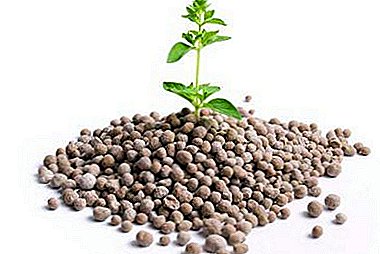 Phosphorus strengthens the resistance of plants to diseases and pests. A sufficient phosphorus content contributes to the formation and strengthening of the root system, and also accelerates the formation of fruits. Increased phosphorus content prevents the production of zinc. You can find out more about phosphate fertilizers here.
Phosphorus strengthens the resistance of plants to diseases and pests. A sufficient phosphorus content contributes to the formation and strengthening of the root system, and also accelerates the formation of fruits. Increased phosphorus content prevents the production of zinc. You can find out more about phosphate fertilizers here.- Potassium accelerates and improves the ripening process, helps to create immunity against fungal diseases that are characteristic of greenhouses. In addition, potassium forms a culture's resistance to adverse conditions.
These three macronutrients are basic in the nutrition of greenhouse tomatoes. They are responsible for the formation of the aerial parts of the plant and the taste of the fruit. The consequence of insufficient maintenance of any of them is a fallen harvest. In addition to the main macroelements, trace elements also influence the growth and development of tomatoes.
- Boron responsible for the formation and development of fruit ovaries, and is also used in the treatment of various diseases. It helps to strengthen the immunity of the culture.
- Manganese responsible for the process of photosynthesis, which is extremely important in plant life. Without it suffers the leaf cover of tomatoes, with dry spots appearing on the leaves.
- Zinc takes part in the exchange of nutrients and the biosynthesis of vitamins, evenly nourishes plants with top dressing elements.
- Magnesium accelerates the process of creating chlorophyll. It is desirable that the fertilizer contains molybdenum, as it controls the exchange of macronutrients.
- Sulfur carries out the synthesis of amino acids, and then proteins. It distributes and transports beneficial elements throughout the plant.
- Presence of enough calcium in the soil is necessary, as it promotes the assimilation of elements and the exchange of useful substances.
When, what fertilizers are used and how do they feed according to the development phase?
Scheme for closed ground
To feed the greenhouse during the season, fertilizers are applied three times.
- First time - two weeks after the transfer of seedlings under the shelter.
To do this, prepare such a compound: 200 g of ammonium nitrate, 500 g of double superphosphate and 100 g of potassium chloride is diluted in 100 liters of water.
- Second feeding produced during the formation of the ovary.
The solution is diluted in 100 liters of water, 300 g of potassium nitrate and 800 g of superphosphate are added thereto. The mixture is poured directly under the root of the bushes.
- The third time greenhouse tomatoes are fed when ripe.
400 g of potassium nitrate and 400 g of superphosphate are thrown into the same volume of water.
The first procedure in the germination of seeds
All seeds of hybrid varieties, which are bought in specialized stores, are subjected to preprocessing during packaging. They are decontaminated and sprout in the prepared soil of preliminary germination. If the seeds are not purchased, but collected, they are disinfected with potassium permanganate.
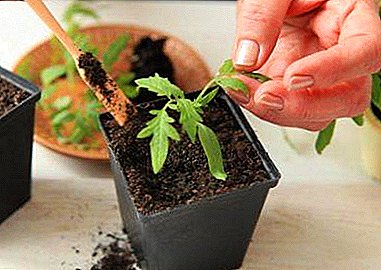 The first top dressing is carried out after picking, therefore, nutrients are included in the seed substrate. Before the first fertilizer, sprouts feed on what contains soil.
The first top dressing is carried out after picking, therefore, nutrients are included in the seed substrate. Before the first fertilizer, sprouts feed on what contains soil.- Two weeks after the dive, the first fertilizer application occurs. For this purpose, complexes containing macro- and microelements are used. Choose the chelated form of trace elements: it breaks down into particles that young plants are able to assimilate. If the form is sulphate, young sprouts do not assimilate its decay products.
- After the first feeding follow the growth and development of culture, with a slowdown in growth after ten days, repeat the procedure. The complex mixture can be replaced with a solution: 3 g of potassium, 8 g of superphosphate, 1 g of nitrate are thrown into a liter of water. To feed each bush takes 500 g of the composition.
Additionally, you can learn about the first feeding of seedlings of tomatoes here, and here we told how to do this before and after picking.
When landing
Before planting in the greenhouse, the soil is prepared, crushed eggshell and ash are added to the wells in small quantities (it is rich in essential elements). Mineral fertilizers can not be poured into the wells, high concentrations are harmful to the roots, the same applies to manure or humus.
After landing
It is recommended to pour them with infusion of crushed herbs (nettle, plantain) immediately after planting. Wood ash and mullein are added to the grass, it is all mixed up, and after a couple of days it is diluted with water in a ratio of 1: 8. When watering consumption is 2 liters per bush.
Tomatoes in bloom
During this period, the culture is experiencing an acute shortage of potassium and phosphorus, and nitrogen at that time is more than enough. It is impossible to add flowering tomatoes to urea. When flowering, potash and phosphate fertilizers will be the best. Used fertilizer to stimulate growth. These include yeast, boric acid. In addition, boric acid is essential for controlling late blight.
Solution recipe: 10 g of the substance is thrown into 10 liters of hot water. When the water cools, the tomatoes are sprayed, and approximately 100 ml of liquid are consumed per square meter.
Important! To increase the yield in the greenhouse it is necessary to stimulate pollination. To increase the number of ovaries, the room is aired and the blooming brushes are periodically shaken; such shaking promotes the transfer of pollen to neighboring bushes.
Foliar fertilizers
By foliar treatment include spraying the aerial parts of the plant. Through the leaves, the plant quickly assimilates the necessary elements. This method is used to achieve the desired result in a short time. In this case, the solutions should not be concentrated.
Mineral fertilizers are also used in a dry form, scattering them on wet soil. During the flowering period for tomatoes it is recommended to use a folk remedy - ash with water (2 cups of ash per 10 liters of water); copper sulphate and manganese sulphate 1: 2. The treatment is carried out in cloudy weather to avoid sunburn.
More information about foliar nutrition can be found here.
How to recognize the need for foliar feeding?
The lack of each element has its own characteristics.
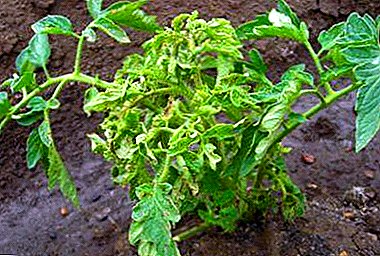 With a deficit of boron, there is a curvature of the top of the bush, the appearance of brown spots on the fruit and yellowness at the base of the shoot.
With a deficit of boron, there is a curvature of the top of the bush, the appearance of brown spots on the fruit and yellowness at the base of the shoot.- With a lack of zinc, small leaves appear with brown spots, gradually filling the entire leaf, and with something like sunburn.
- If magnesium is absent, the leaves between the veins turn yellow or discolor.
- With a lack of molybdenum leaves curl, there are signs of chlorosis.
- If there is not enough calcium, there are external changes in young leaves, their tips dry up, and then the entire leaf plate, while the old leaves grow and darken. The tops of the fruits begin to rot, and with an acute lack of calcium, the top of the bush can generally die off.
- Sulfur deficiency gives very thin stems, leaves turn light green and gradually turn yellow.
- If there is no iron, first of all, the foliage at the base turns yellow, then they turn white with green veins.
- A shortage of manganese has the same signs, but yellowness does not appear at the bottom, but is distributed randomly.
- With a lack of nitrogen bush fade rapidly, starting with the lower leaves.
- Deficiency of phosphorus gives the plant a purple color, if the lack of an insignificant, the stem and the lower part of the bush acquire the lack of a purple hue.
- The lack of potassium results in poor flowering and a small number of ovaries.
To fill the deficiency of nutrients
- As a growth stimulator, ordinary yeasts are suitable, they saturate a tomato with useful substances and strengthen the immune system. For the solution take:
- small bag of yeast;
- 2 tbsp. l Sahara;
- some warm water to dissolve it all;
- The mass is diluted with 10 liters of water; half a liter of liquid is required for each plant.
- Once or twice a season, tomatoes are fed with iodine. For 100 liters of water, 40 drops are needed, the bushes are sprayed abundantly, 2 liters each. on the bush.
- It is useful to do foliar treatment with ashes at any stage of growth, the consumption of the composition is the same as in the previous cases. The solution consists of 10 glasses of ash per 100 liters of water.
In conclusion, it is worth noting that regular and timely fertilization of greenhouse tomatoes is also necessary, like watering and weeding. In addition to the purchase of complex fertilizers, also use compositions made from improvised means. Of course, you need to know the measure, since an increased amount of mineral fertilizers leads to a deterioration in the taste of tomatoes.


 Phosphorus strengthens the resistance of plants to diseases and pests. A sufficient phosphorus content contributes to the formation and strengthening of the root system, and also accelerates the formation of fruits. Increased phosphorus content prevents the production of zinc. You can find out more about phosphate fertilizers here.
Phosphorus strengthens the resistance of plants to diseases and pests. A sufficient phosphorus content contributes to the formation and strengthening of the root system, and also accelerates the formation of fruits. Increased phosphorus content prevents the production of zinc. You can find out more about phosphate fertilizers here. The first top dressing is carried out after picking, therefore, nutrients are included in the seed substrate. Before the first fertilizer, sprouts feed on what contains soil.
The first top dressing is carried out after picking, therefore, nutrients are included in the seed substrate. Before the first fertilizer, sprouts feed on what contains soil. With a deficit of boron, there is a curvature of the top of the bush, the appearance of brown spots on the fruit and yellowness at the base of the shoot.
With a deficit of boron, there is a curvature of the top of the bush, the appearance of brown spots on the fruit and yellowness at the base of the shoot.